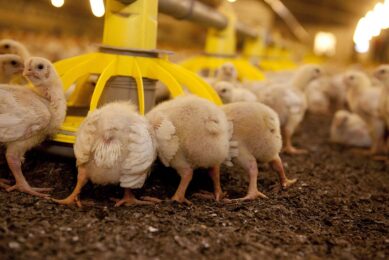6 steps to become a broiler health champion

Whether caring for chickens or children, poultry farmers and parents share a common interest in reducing the use of antimicrobials.
Consumer demand for protein raised without antibiotics is prompting farmers to rethink the use of antimicrobials in their flocks. Meanwhile, rising rates of antimicrobial resistance present a concern for both human and chicken health.
This dilemma recently brought about an epiphany as I realised the tailored approach to antimicrobial reduction delivered in Trouw Nutrition’s integrated Feed Farm Health programme is rooted in the same principles supporting human efforts to reduce AMR.
Our 7-year-old son experienced a bacterial infection, was prescribed a course of antibiotics and briefly hospitalised after 3 days of treatment. He appeared to recover but the same symptoms reappeared 2 weeks later. After a paediatrician consult and swab (for antibiogram), a second round of antibiotics was prescribed. While it would have been convenient to simply administer antibiotics, I considered a more tailored approach to treat my son’s symptoms. I closely monitored his diet, water intake, rest and body temperature – and he began to improve. Within 3 days, he recovered his health and his athletic performance was restored. In fact, he was placed first in a gymnastics competition!
On the day of the competition we received the antibiogram results – but he didn’t need treatment anymore. I realised that the tailored approach I had used at home shared similarities with the Trouw Nutrition feed, farm and health management approach aimed at keeping flocks healthy and performing consistently. Clearly, a child is not a chicken, but how can we tailor AMR success for the poultry farm? The better we can tailor interventions to the challenges at hand, the less we will need to rely on antibiotics. Below, we look at a 6-step approach to achieving high-performing flocks, cycle after cycle, without the use of antibiotics.
 Synergistic feed additive strategy to reduce antimicrobials
Synergistic feed additive strategy to reduce antimicrobials
Gut health is an enduring challenge for broiler producers. Essential to ensuring optimum absorption of nutrients in the bird, gut health is a key factor in supporting immunity.
Step 1: Identify the AMR goal
Clarify the purpose and desired outcome of an antibiotic reduction effort. Some suppliers want to farm entirely without antibiotics, others want to decrease their reliance on antimicrobials, while others are seeking a certification, such as Raised Without Antibiotics. Successful antimicrobial reduction efforts require commitment across the organisation and a high-level meeting will set out expectations at the start. Questions to address include: What is the desired antimicrobial reduction to be achieved on the farm, and what is the timeframe for achieving the goal? The responses can inform a practical plan with clearly defined roles for all team members. Usually antimicrobial reductions are implemented incrementally, with successive reductions made only after positive evaluations (see Figure 1 – step 6).
Figure 1 – Trouw Nutrition AMR customized step-wise approach.

Step 2: Audit feed, farm, health baselines
Measuring progress requires establishing a benchmark for comparison. Conditions related to feed, farm and health must be evaluated.
- Feed management: Consider the breed (i.e. Ross or Cobb) when evaluating feed intake and feeding schedule. A baseline scorecard should address questions such as: How long does it take day-old chicks to eat and what is their feed intake? What is the nutritional analysis of the feed and is it consistent? Are levels of anti-nutritional factors, such as mycotoxins, moulds, and Enterobacteriaceae within acceptable feed safety ranges? If thresholds are exceeded, what levels need to be reduced? Is feed structure sufficient to support gizzard function while respecting pellet quality?
- Farm management: Day-old chicks are vulnerable, so evaluate new arrivals’ quality, including weight uniformity and body temperature. Consider the climate of the chick house. Is the temperature range appropriate and the floor sufficiently warm? Does the ventilation need to be adjusted? Is fresh feed placed on chick paper and do chicks feel comfortable so that they eat? New chicks must quadruple their bodyweight in the first week, putting enormous pressure on the gastrointestinal tract. Do the broilers have easy access to feeders and drinkers along the cycle? How is the biosecurity? Is the floor hygiene well managed?
- Health management: It is important to know what antibiotics are being used on the farm and for what purpose. The following questions help inform a baseline: Are the antibiotics consistently effective and if not, why not? Are antibiograms done? Is there a customised anticoccidial rotation programme in place, as well as a properly administered customised vaccination schedule? What feed and drinking water additives are used? In addition to inputs, evaluate animal droppings for consistency and quality. Necropsies should evaluate dysbacteriosis scoring, and provide gizzard and coccidiosis scores.
Step 3: Introduce custom solutions
Only after an audit (preferably spanning the entire production chain) should targeted solutions be introduced. Beyond the primary options described in previous articles, other options include products, models and service interventions. Examples include:
Feed management
- ChickCare: High quality feed for chicks’ first days of life
- Models: NutriOpt structure concept delivers feed formulation advice to improve gizzard function
- Mycotoxin Risk Management (MRM): Programme mitigates mycotoxin risks directly or via mould control
Farm management
- Service: Advice on house climate, positioning of feeders and drinkers according to the age of the broilers and other environmental considerations
Health management
- Products: Strategic use of a synergistic combination based on 4 pillars delivering targeted modes of action (e.g. Selko Presan-FY and Selko IntelliBond C)
- Service: Dysbacteriosis gut health scoring
 Improving yellow skin pigmentation in broilers fed AGP-free
Improving yellow skin pigmentation in broilers fed AGP-free
When reducing or eliminating antimicrobial growth promoters (AGP) in poultry production, producers must pay careful attention to feed, farm and health challenges.
Step 4: Return on Investment (ROI)
Compare the resources (feed adaptations, feed additives, etc.) required to implement suggested solutions with the potential return based on prices (e.g. feed and meat prices) and past experience. A solid AMR strategy must make sense in terms of efficacy and producer economics. If not, a new review of needs and solutions is in order.
Step 5: Implementation
Now the real work begins. Team members at the customer’s site representing various fields of expertise connect with their corresponding expert at Trouw Nutrition: farm manager, nutritionist or vet. Experts from the Trouw Nutrition global innovation team support the team in the field.
Step 6: Evaluate, Adapt, Repeat
Finally, we assess whether the implemented intervention meets the customer’s need as outlined in step 1. When this has been achieved, we proceed to the next step until we reach the next level of antibiotic reduction. The process is repeated until the final goal is achieved. In a dynamic marketplace, the initial goal will inevitably be fine-tuned over time. Consistently deploying a 6-step cycle which integrates feed, farm and health management, can take an AMR programme from vision to achievement.
This article follows previous instalments on farm, feed and gut health on how to reduce antimicrobials while maintaining performance.
Author: Barbara Brutsaert, Trouw Nutrition
Join 31,000+ subscribers
Subscribe to our newsletter to stay updated about all the need-to-know content in the poultry sector, three times a week. Beheer
Beheer








 WP Admin
WP Admin  Bewerk bericht
Bewerk bericht